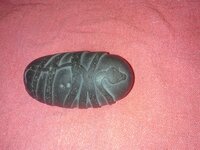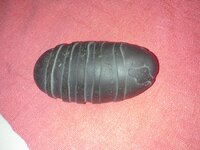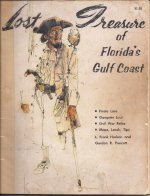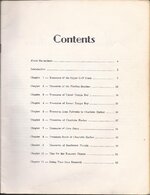PatrickD
Hero Member
- Jul 23, 2012
- 845
- 704
- Detector(s) used
- Garrett AT Pro
- Primary Interest:
- All Treasure Hunting
On the trail of a mid 1500's Spanish Expedition
Hi Everyone,
I am uploading some information regarding one of the Spanish expeditions through the US back in the 1500's.
Please post a response and let me know what you think. (See the pictures at the bottom of this post.)
Good luck in your hunting,
Patrick
-------------------------------------------
First, a short history lesson
-------------------------------------------
Hernando Desoto & Luis Moscoso - (From the Texas State Historical Association)
---
MOSCOSO EXPEDITION. Luis de Moscoso Alvarado was a member of Hernando De Soto's expedition to explore La Florida-today's southeastern United States-and to obtain gold and other riches from the native peoples of the North American continent. The army of an estimated 600 men sighted land on May 25, 1539, on the western coast of Florida near what is now Tampa Bay, and landed on May 30. Over the next four years the expedition traveled throughout the southeastern United States. On May 21, 1542, De Soto died from a fever at the Mississippi River in what is now Arkansas; command of the expedition was transferred to Moscoso. The remainder of the journey is commonly known as the Moscoso expedition. The primary goal of its surviving members was to find an overland route back to New Spain (now Mexico). Many attempts have been made to reconstruct the route of the expedition, nearly all of which bring it into Texas in the summer of 1542.
Scholars have attempted to trace the Moscoso expedition route through Texas mainly with information found in four primary accounts of the journey. A brief version of the army's exploits in La Florida is found in a narrative by the King's factor, Luys Hernández de Biedma, who accompanied Moscoso. This account was written eleven years after the expedition, while Biedma was living in Mexico. Another account is the True Relation of the Hardships Suffered by Governor Fernando de Soto and Certain Portuguese Gentlemen During the Discovery of the Province of Florida. Now Newly Set Forth by a Gentleman of Elvas. This work first appeared in 1557-just fourteen years after the expedition-and was produced anonymously by a Portuguese member of the expedition. A third written source is a romanticized account of the expedition by Garcilaso de la Vega, entitled A History of the Adelantado Hernando de Soto. Garcilaso was not a member of the expedition, and his account was written in the latter part of the sixteenth century and published in 1605. It was based on at least two written and one oral account by expedition members. A fourth account was published in 1851 in Gonzalo Fernández de Oviedo's Historia general y natural de las Indias. This account was by De Soto's private secretary, Rodrigo Ranjel.
The most exhaustive early attempt to reconstruct the route of the Moscoso expedition, not only in Texas but through the entire southeastern United States, was published in 1939 by the United States De Soto Commission to celebrate the expedition's 400th anniversary. The commission's proposed version of the route through Texas posits that the expedition, led by Moscoso, entered Texas in what is now Shelby County and from there traveled south to a point near San Augustine. It then turned west and went as far as the Navasota River in east central Texas. At this point the soldiers decided that they would not be able to find enough food to feed the expedition if they continued farther west, and thus the Moscoso expedition retraced its route back to the Mississippi River in Arkansas.
-----------------
Additional Information:
Luis Moscoso was a particularly superstitious man. He was known to carry a 'serpent stone' for good luck. This stone was supposed to have been given to him by Spanish royalty although that is unconfirmed. Only a few references to the serpent stone is found in historical references.
There has been much controversy as to where this doomed expedition spent a winter. There has been some evidence showing that they were on the Rio de los Brazos de Dios. This is also known as the Brazos River. There is speculation as to this exact site. Some references place it as high as around Possum Kingdom lake and as far south as Austin.
This expedition camped on the Brazos for the winter. They almost starved and lost hope abandoning their expedition. Many died on this expedition and Luis Moscoso gave orders. Full of discouragement, Luis Moscoso abandoned his lucky serpent stone as cursed and left it at their camping location. A brass cannon was sealed with Moscoso's journal and a hand scribed bible. The cannon has a value of about $45k and the journal/bible are priceless.
One source shows Moscoso leading the remaining men from his expedition down the Brazos river and into Mexico ultimately returning to Spain humiliated.
------------------------------------------
Now, about the find.
------------------------------------------
Some of the area's old-timers had recalled swimming in the local swimming hole and jumping from a pipe into the water when they were children. The pipe was described as a short thick tube of yellowish metal sticking out of the bank and the end of the pipe was sealed shut with wood jammed into the opening. This is what I was looking for at the time. Not only would this be a valuable find, it would be a find with archeological significance. Of course, none of the old-timers could remember or would reveal the exact location of this swimming hole.
On a brisk fall day, I was exploring some caves along the Brazos river in Palo Pinto county. One particular location seemed like it had been excavated to facilitate a fair amount of people. The opening seemed to widen and the cave itself was nothing more than a large room about 20ft long X 10 ft wide. It also seemed to be a fond spot for copperhead snakes. Just my luck.
Upon entering the cave, a temperature difference was felt immediately. The cave room seemed unusually still as if it had been sealed from time itself. I began searching the cave for signs of habitation. There were no signs of petroglyphs, cave writings or other markings. The ceiling on one end of the cave seemed to be stained darker as if it had known the smoke of many fires.
There was a small ledge protruding on the inside wall of the cave. There was something on the ledge that caught my attention. Covered in a pale dust was a stone about the size of a small potato. The dust clung to my fingers as I retrieved this relic from its resting place.
The stone held the carvings of two snakes intertwined around with a head on both sides. This stone fit the description of remote references to Moscoso's lucky serpent stone.
If this was Moscoso's stone, the cannon isn't far away. This would also rewrite the history books and solve the riddle as to where the Moscoso expedition spent that dreadful winter that killed most of the members.
Here are some pictures of this stone. I make no claims other than finding it in a cave.
----------------------------


Hi Everyone,
I am uploading some information regarding one of the Spanish expeditions through the US back in the 1500's.
Please post a response and let me know what you think. (See the pictures at the bottom of this post.)
Good luck in your hunting,
Patrick
-------------------------------------------
First, a short history lesson
-------------------------------------------
Hernando Desoto & Luis Moscoso - (From the Texas State Historical Association)
---
MOSCOSO EXPEDITION. Luis de Moscoso Alvarado was a member of Hernando De Soto's expedition to explore La Florida-today's southeastern United States-and to obtain gold and other riches from the native peoples of the North American continent. The army of an estimated 600 men sighted land on May 25, 1539, on the western coast of Florida near what is now Tampa Bay, and landed on May 30. Over the next four years the expedition traveled throughout the southeastern United States. On May 21, 1542, De Soto died from a fever at the Mississippi River in what is now Arkansas; command of the expedition was transferred to Moscoso. The remainder of the journey is commonly known as the Moscoso expedition. The primary goal of its surviving members was to find an overland route back to New Spain (now Mexico). Many attempts have been made to reconstruct the route of the expedition, nearly all of which bring it into Texas in the summer of 1542.
Scholars have attempted to trace the Moscoso expedition route through Texas mainly with information found in four primary accounts of the journey. A brief version of the army's exploits in La Florida is found in a narrative by the King's factor, Luys Hernández de Biedma, who accompanied Moscoso. This account was written eleven years after the expedition, while Biedma was living in Mexico. Another account is the True Relation of the Hardships Suffered by Governor Fernando de Soto and Certain Portuguese Gentlemen During the Discovery of the Province of Florida. Now Newly Set Forth by a Gentleman of Elvas. This work first appeared in 1557-just fourteen years after the expedition-and was produced anonymously by a Portuguese member of the expedition. A third written source is a romanticized account of the expedition by Garcilaso de la Vega, entitled A History of the Adelantado Hernando de Soto. Garcilaso was not a member of the expedition, and his account was written in the latter part of the sixteenth century and published in 1605. It was based on at least two written and one oral account by expedition members. A fourth account was published in 1851 in Gonzalo Fernández de Oviedo's Historia general y natural de las Indias. This account was by De Soto's private secretary, Rodrigo Ranjel.
The most exhaustive early attempt to reconstruct the route of the Moscoso expedition, not only in Texas but through the entire southeastern United States, was published in 1939 by the United States De Soto Commission to celebrate the expedition's 400th anniversary. The commission's proposed version of the route through Texas posits that the expedition, led by Moscoso, entered Texas in what is now Shelby County and from there traveled south to a point near San Augustine. It then turned west and went as far as the Navasota River in east central Texas. At this point the soldiers decided that they would not be able to find enough food to feed the expedition if they continued farther west, and thus the Moscoso expedition retraced its route back to the Mississippi River in Arkansas.
-----------------
Additional Information:
Luis Moscoso was a particularly superstitious man. He was known to carry a 'serpent stone' for good luck. This stone was supposed to have been given to him by Spanish royalty although that is unconfirmed. Only a few references to the serpent stone is found in historical references.
There has been much controversy as to where this doomed expedition spent a winter. There has been some evidence showing that they were on the Rio de los Brazos de Dios. This is also known as the Brazos River. There is speculation as to this exact site. Some references place it as high as around Possum Kingdom lake and as far south as Austin.
This expedition camped on the Brazos for the winter. They almost starved and lost hope abandoning their expedition. Many died on this expedition and Luis Moscoso gave orders. Full of discouragement, Luis Moscoso abandoned his lucky serpent stone as cursed and left it at their camping location. A brass cannon was sealed with Moscoso's journal and a hand scribed bible. The cannon has a value of about $45k and the journal/bible are priceless.
One source shows Moscoso leading the remaining men from his expedition down the Brazos river and into Mexico ultimately returning to Spain humiliated.
------------------------------------------
Now, about the find.
------------------------------------------
Some of the area's old-timers had recalled swimming in the local swimming hole and jumping from a pipe into the water when they were children. The pipe was described as a short thick tube of yellowish metal sticking out of the bank and the end of the pipe was sealed shut with wood jammed into the opening. This is what I was looking for at the time. Not only would this be a valuable find, it would be a find with archeological significance. Of course, none of the old-timers could remember or would reveal the exact location of this swimming hole.
On a brisk fall day, I was exploring some caves along the Brazos river in Palo Pinto county. One particular location seemed like it had been excavated to facilitate a fair amount of people. The opening seemed to widen and the cave itself was nothing more than a large room about 20ft long X 10 ft wide. It also seemed to be a fond spot for copperhead snakes. Just my luck.
Upon entering the cave, a temperature difference was felt immediately. The cave room seemed unusually still as if it had been sealed from time itself. I began searching the cave for signs of habitation. There were no signs of petroglyphs, cave writings or other markings. The ceiling on one end of the cave seemed to be stained darker as if it had known the smoke of many fires.
There was a small ledge protruding on the inside wall of the cave. There was something on the ledge that caught my attention. Covered in a pale dust was a stone about the size of a small potato. The dust clung to my fingers as I retrieved this relic from its resting place.
The stone held the carvings of two snakes intertwined around with a head on both sides. This stone fit the description of remote references to Moscoso's lucky serpent stone.
If this was Moscoso's stone, the cannon isn't far away. This would also rewrite the history books and solve the riddle as to where the Moscoso expedition spent that dreadful winter that killed most of the members.
Here are some pictures of this stone. I make no claims other than finding it in a cave.
----------------------------


Last edited:
Upvote
0


 you mention a cannon nearby where you recovered this relic , dragging a cannon around in uncharted territory seems like a lot of work and a bad idea
you mention a cannon nearby where you recovered this relic , dragging a cannon around in uncharted territory seems like a lot of work and a bad idea  anyhow .. what's next
anyhow .. what's next





